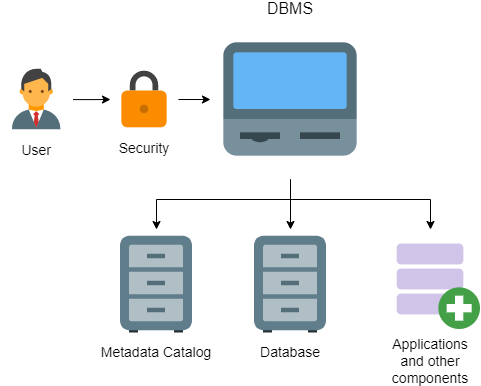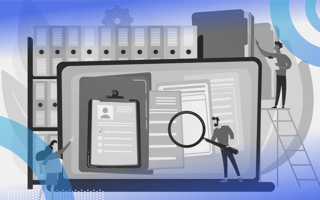A database management system (DBMS) is software used to create, manage and interact with databases. It serves as the interface between users and the stored data, enabling operations like creation, retrieval, updates and deletions.
What Does a Database Management System (DBMS) Do?
A database management system (DBMS) is a software system that acts as an interface between users and data stored in a database, thereby allowing users to create, read, update and delete data in a database. A DBMS manages the database engine, policies and schema needed for users to extract any data they may need.
A DBMS requires these key parts to come together:
- Data: The information stored in a database. Text, numbers, booleans (i.e. true/false statements) and dates typically represent our data.
- Database: An organized collection of data. A database lets data be easily stored and accessed.
- Schema: The blueprint of a structured database. A schema explains the type of data stored in a database and how the data is related.
- Database engine: The core service of a DBMS that handles storage, retrieval and query processing tasks.

Components of a Database Management System
In addition to a database engine, there are several other components and tools normally contained within a DBMS.
- Database engine
- Query language
- Query processor
- Optimization engine
- Metadata catalog
- Monitoring tools
- Quality assurance tools
1. Database Engine
A database engine is the core of any DBMS. It’s the software that interacts with the data, database users and the query processor.
2. Query Language
A DBMS requires a database access language in order for users to interact with a database. A query language defines a set of commands and rules that allow a DBMS to know when users want to create databases, as well as insert, update or delete data. The most popular and commonly used database query language is Structured Query Language (SQL). Some database management systems inherit or extend SQL while adding their own features such as PostgreSQL or MySQL.
3. Query Processor
A query processor uses the established query language to interpret the queries executed by users and converts them into proper, compatible commands for the database. A query processor parses, translates, optimizes and evaluates a query.
4. Metadata Catalog
In simple terms, a metadata catalog is a collection of all the data about your data. All data stored in a database has some information regarding its lifetime and journey, such as the creation timestamp or the user who inserted the data. All this information is known as metadata and it is stored in the DBMS metadata catalog. A metadata catalog’s main function is providing an overarching view and deeper visibility into all of the data managed by a DBMS.
5. Monitoring Tools
Monitoring a DBMS helps to optimize performance, protect our databases and reduce downtime. There are a variety of metrics users can monitor in a DBMS such as CPU, memory performance or system downtime. There is a whole market of tools available out there such as SolarWinds, SQL Power Tools and Datadog to do this work within a DBMS.
6. Quality Assurance Tools
To ensure that our DBMS manages data correctly, it is important to monitor the veracity of the data populating our databases. DBMS software has its own built-in software quality assurance tools for data integrity checks, database repair and data validations.
Types of Database Management Systems
Databases tend to be relational or non-relational and this is based on the type of data they handle. Relational databases store data in tables whereas non-relational databases store data in JSON documents or key-value pairs. Additionally, graph databases store nodes and their relationships.
Just as there are relational, non-relational and graph databases, in the same way, there are relational database management systems (RDBMS), non-relational database management systems or graph database management systems.
1. Relational Database Management System (RDBMS)
Relational databases store structured data, which is based on tables that contain rows and columns. Data is stored in rows that contain a unique ID known as the primary key. Users can then link multiple tables with each other based on common values such as product ID or customer name.
An RDBMS is used to manage relational databases — sometimes called SQL databases. This is because SQL is used to interact with relational database management systems. Some popular RDBMSes include MySQL and Microsoft SQL.
It is worth noting that many people may refer to MySQL as a database when, in reality, it is a DBMS.
Another popular example of an RDBMS is a data warehouse. A data warehouse is a relational database management system used to manage databases that store data in columns rather than rows. Columnar databases are a good choice for data analytics. Some examples of cloud-based data warehouses that used columnar data are BigQuery from Google Cloud Platform or Redshift from Amazon Web Services.
2. Non-Relational or NoSQL Database Management System
A document-oriented database management system is a type of NoSQL system that stores data in JSON-like documents. It is often used to manage non-relational databases. Non-relational databases normally contain JSON-like structures that resemble objects or documents.
Unlike relational databases, data in non-relational databases have no set structure or relationship and are powered by services such as MongoDB (one of the most popular NoSQL platforms) or DynamoDB.
3. Graph Database Management System
A graph database management system provides specific support for the deployment and maintenance of graph databases. A graph database is used to store data in the form of nodes and connections. This is a great option to navigate deep hierarchies and to find hidden connections between items of a network. Graph databases can be used to model transport networks, recommendation engines and fraud detection systems.
Some popular choices of graph database management systems are Neo4j, ArangoDB, OrientDB and TigerGraph.
Advantages of Database Management Systems
Improved Data Security
A DBMS acts as the middleman between databases and users, providing enhanced data security. The more often users need to access a database, the higher the risk of a security breach. With a DBMS, users can implement security policies that define permissions regarding who can access what and where data is allowed to be stored. A DBMS allows us to have strict control over the data’s journey within our system.
Privacy Compliance
A DBMS provides a framework for compliance with data privacy policies, which allows companies to manage privacy and security in a centralized manner. Privacy compliance is all about using data responsibly, whereas data security is simply about protecting all our data from malicious threats. Ultimately data privacy comes down to following regulations to clearly establish what data is protected, how it’s protected, from whom it’s protected and who is responsible for that protection.
Data Integrity
Data integrity ensures data is accurate, consistent and reliable. It includes enforcing data types, constraints, relationships between tables and validation rules.
Disadvantages of Database Management Systems
Cost of Implementation and Maintenance
Implementing and maintaining a DBMS can be a costly investment, as new technologies likely need to be adopted during set up and trained staff is needed to maintain the system.
Complexity
A DBMS is leveraged to create, modify and manage databases, which can also hold critical or sensitive data. Navigating a DBMS properly can be complex and require technical knowledge to keep data organized.
Expertise Required
Due to maintenance needs and system complexity, specialized expertise is often required to handle DBMS tasks. This means businesses will likely have to hire additional staff or use a third-party provider to manage its database.
Use Cases of Database Management Systems
Data Storage and Scalability for Growing Industries
A DBMS is used to directly manage data and databases, including storing data as intended inside a database. DBMSs are also used to organize data in a way that enables data scalability, and still manage data effectively as it may increase in volume. Industries with ever-growing data, like healthcare, finance and technology, largely benefit from using DBMSs and databases to handle this information.
Data Analytics for Retail, Healthcare and Finance
Databases are crucial for performing data analytics and retrieving insights on gathered data. DBMSs ensure this data is correctly structured, sorted and easily accessible to prepare it for analysis. DBMSs are commonly used to keep data research-ready in industries like retail, healthcare, finance and education.
Data Security and Integrity for Healthcare, Banking and Government
A DBMS often applies user authentication and other access control measures to ensure only authorized personnel can modify the data inside a database. DBMSs also organize data in a way where it is identifiable, consistent and prepared for backups, helping boost data integrity. Both of these types of measures keep data secure, and safeguard data in the case of data loss or data leaks. This makes DBMSs a standard to industries that handle sensitive data, such as healthcare, banking or government.
Frequently Asked Questions
What is a database management system?
A database management system (DBMS) is a software system for creating, modifying and managing databases. A DBMS lets users create, read, update and delete data stored within a database, and efficiently access and organize this data at various scales. DBMSs also help maintain data security and integrity for a database. The main components of a DBMS include hardware, software, data, procedures and database access language.
What are the types of database management systems?
The main types of database management systems are:
- Relational database management system (RDBMS)
- Non-relational or NoSQL database management system (i.e. document-oriented database management system)
- Graph database management system
- Hierarchical database management system
- Network database management system
- Object-oriented database management system
What are examples of database management systems (DBMSs)?
MySQL, MongoDB, Microsoft SQL Server and Oracle DBMS are examples of database management systems (DBMSs).
How does a database management system enhance data security?
A database management system serves as an interface between users and the database, allowing organizations to implement strict security policies. It controls who can access data, where it can be stored, and how it moves within the system, helping reduce the risk of data breaches.
What is the difference between a database and a DBMS?
A database is an organized collection of data, while a database management system (DBMS) is the software that creates, modifies and manages that data. The DBMS handles user interactions, enforces policies, and provides tools for querying and maintaining the database.
What are the core components of a database management system?
Key components of a database management system (DBMS) include:
- Database engine
- Query language
- Query processor
- Optimization engine
- Metadata catalog
- Monitoring tools
- Quality assurance tools
DBMS components work together to manage data effectively and securely.





